Broken Arrow
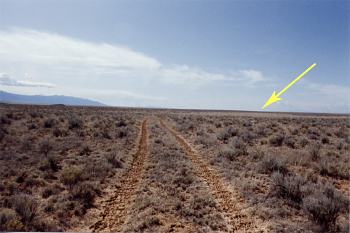
VIEW OF THE IMPACT SITE FROM THE NORTH. THE ARROW POINTS TO THE SITE IN THE OPEN GRASSY AREA |
In 1986, an Albuquerque newspaper acquired the accident report through the Freedom of Information Act. The true identity of the weapon was revealed publicly for the first time, and the account was widely published. Pete Merlin read the article, as published in the Los Angeles Times, with great interest.
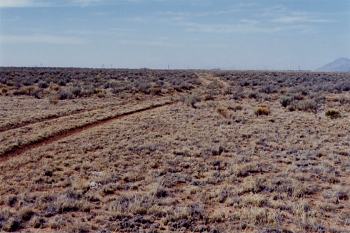
VIEW LOOKING NORTH ALONG THE JEEP TRAIL AT THE NORTHEAST CORNER OF THE SITE |
Six years later, he began to entertain the idea of searching for the Mk.17 impact site. Considering that it had fallen just outside Kirtland AFB, on a flat cow pasture, it seemed reasonable to assume that the Air Force had thoroughly cleaned up the site. The incident occurred at the height of the Cold War. At the time, nuclear weapon design details were not widely known and were considered highly classified. That and the possibility of radioactive contamination should have motivated the cleanup crews to sanitize the site. Pete's experience with aerospace archeology up to that point had convinced him that, however slight, there was still a possibility of finding something.
On 18 March 1993, he searched for the impact site with Mark Miller. The location had been described as 4.5 miles south of the Kirtland AFB control tower and three-tenths of a mile west of the base boundary fence. They drove to within a few miles of the site, but the road was blocked with a fence surrounding the cow pasture. The terrain was flat and featureless. There were no landmarks to guide them.
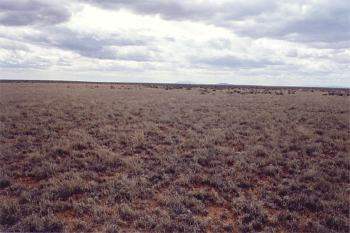
VIEW OF THE IMPACT SITE LOOKING SOUTHWEST FROM THE JEEP TRAIL |
According to the map, they were one mile west of the Kirtland fence line. It took 20 minutes to walk that distance. Along the way, they found a few pieces of aircraft aluminum. These later turned out to be parts of a Douglas B-26. They also passed a jeep trail that headed south, about a quarter mile or so west of the fence.
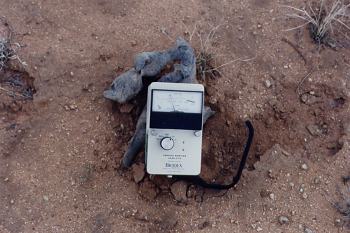
A SAMPLE OF LEAD SHOWING SIGNS OF RADIOACTIVITY. THIS SAMPLE PRODUCED A SURFACE READING OF 0.5 mR/hr.- NATURAL BACKGROUND IN THE AREA IS APPROXIMATELY 0.025 mR/hr. |
Upon reaching the fence line, they hiked south for another 20 minutes and then west for six minutes. This took them back to the jeep trail. Pete decided that they should follow the jeep trail south. After a minute or two, they entered an area that was very flat and grassy. It was a clearing surrounded by sagebrush and scrub. Pete immediately spotted fragments of a brown, lightweight, layered material. After a few moments, he realized that these were parts of the cork-micarta liner from the interior of the bomb casing. An expanded search of the clearing revealed chunks of steel and lead. Shredded parachute lines, melted plastic, and aluminum structural components littered the surrounding landscape.
The location was indeed exactly as described, but there was no evidence of the crater. It had been completely filled in. The materials were consistent with those found in a Mk.17. Using a Geiger counter, Pete determined that a few pieces of debris were slightly radioactive. He collected several uncontaminated pieces that represented different materials and components and later donated them to the National Atomic Museum in Albuquerque.
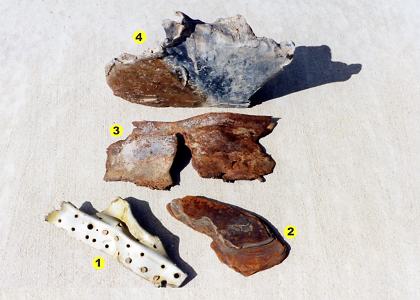
VIEW OF THE 1.ALUMINUM SUPPORT STRUCTURE 2.CORK-MICARTA LINER 3.STEEL 4.LEAD SHIELDING |
|
|

© Copyright 2004-, The X-Hunters. All rights reserved. Copyright Policy Privacy Policy Page last modified 05/01/2023





